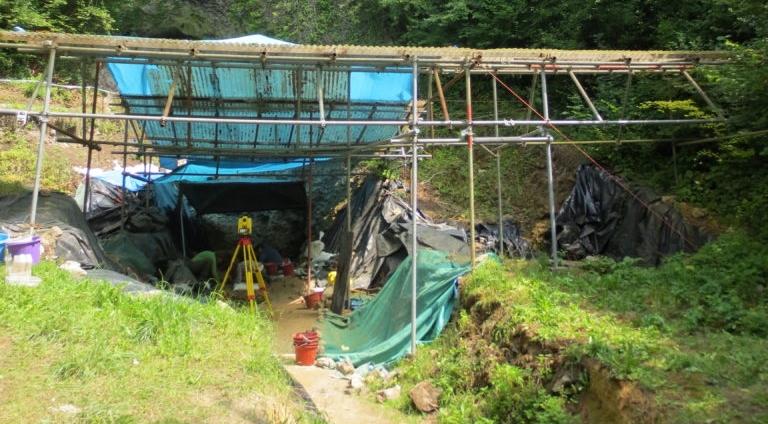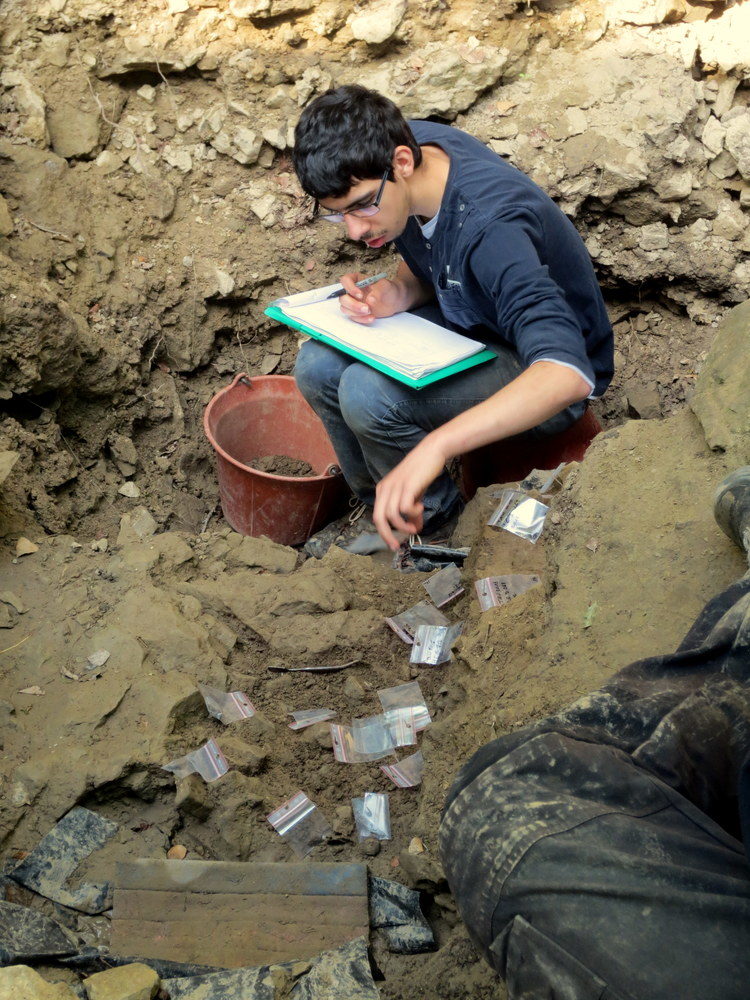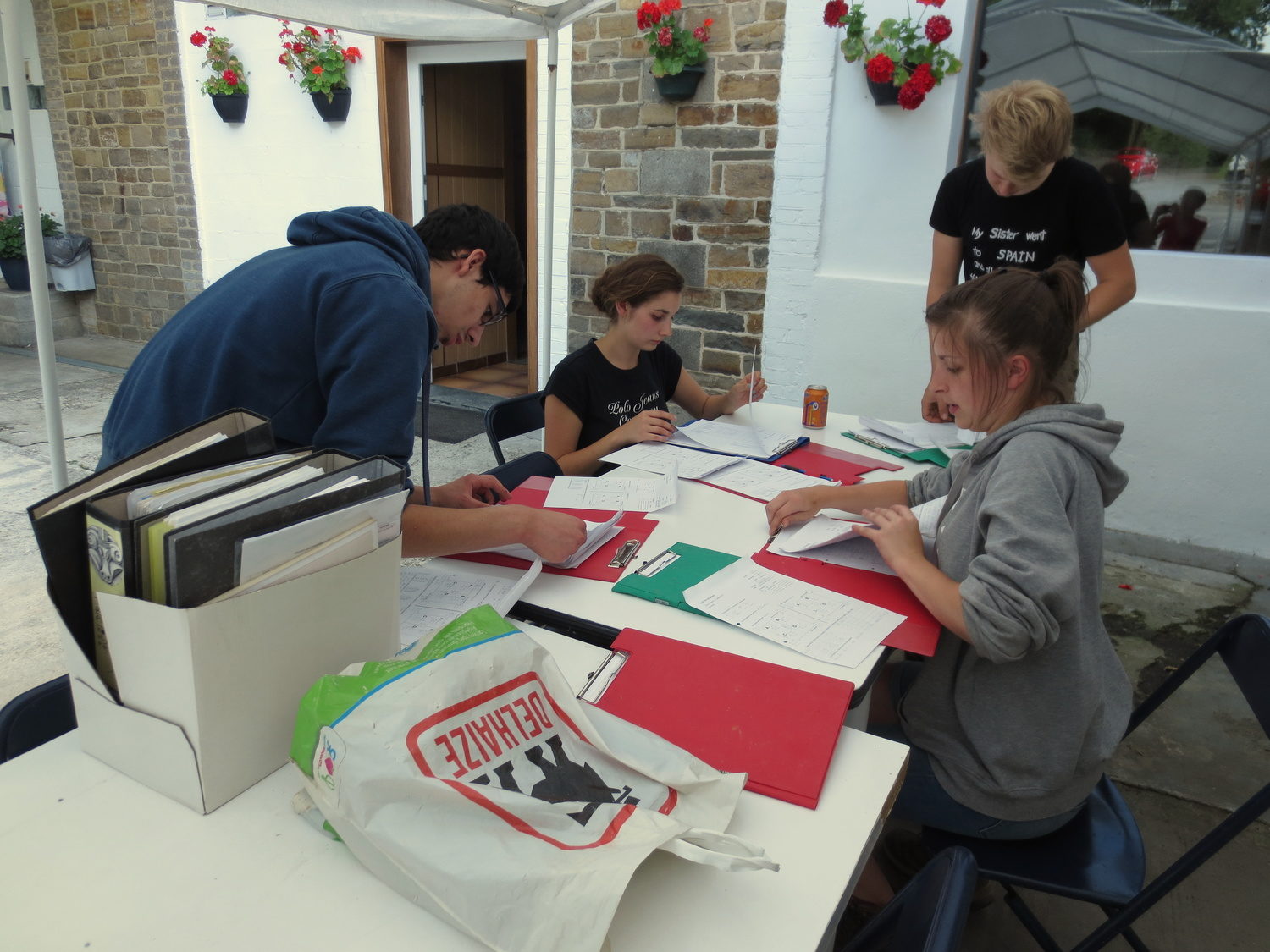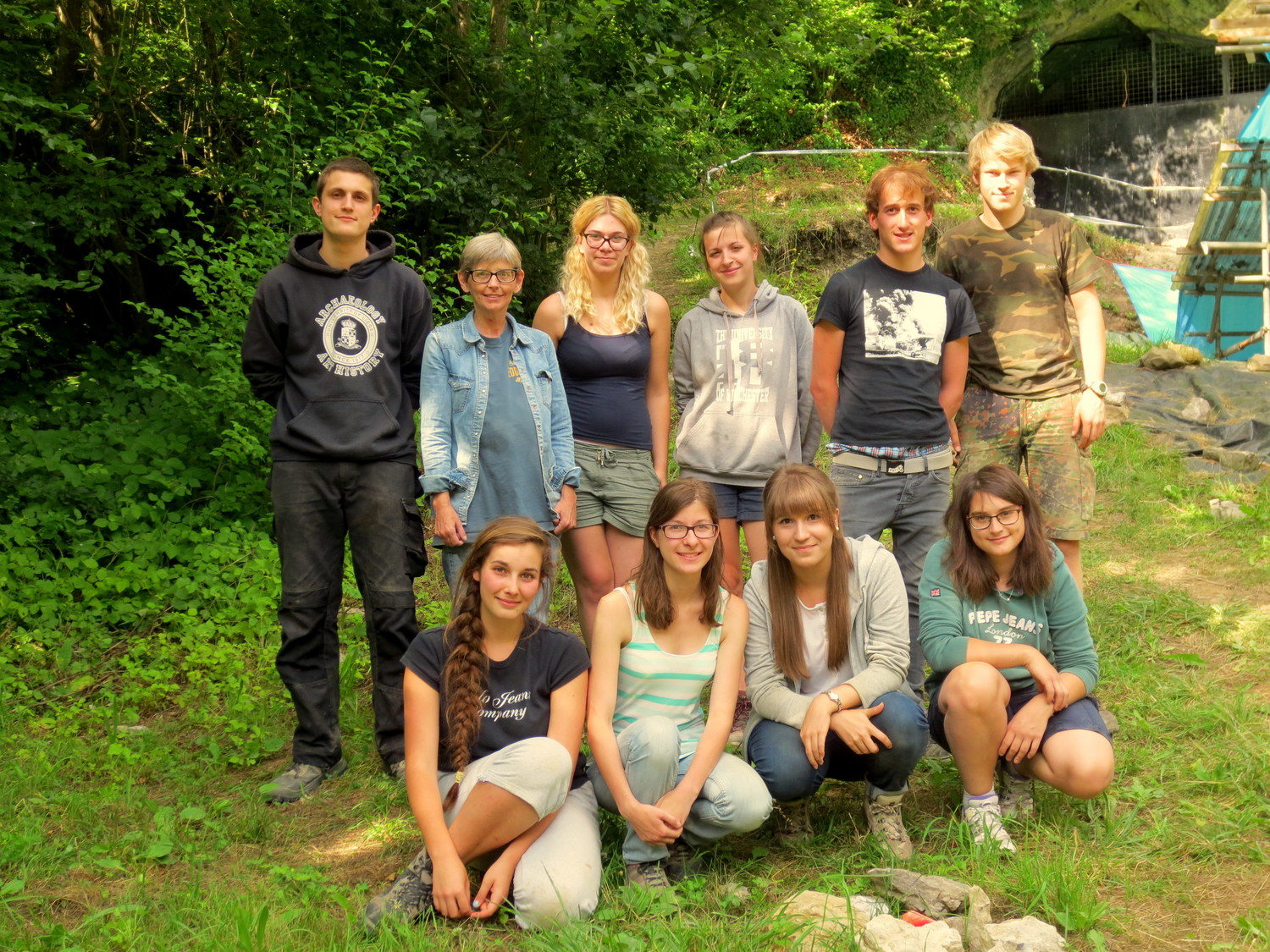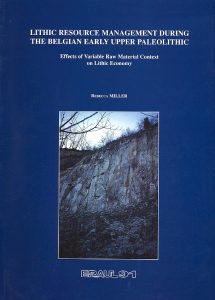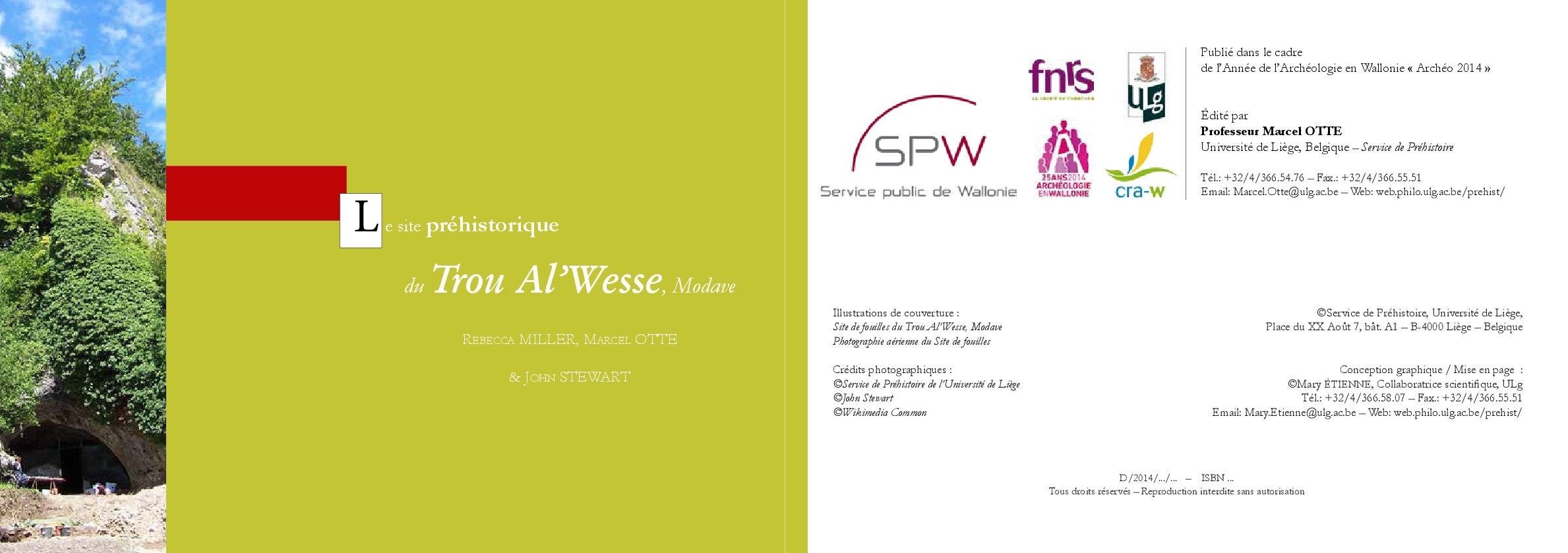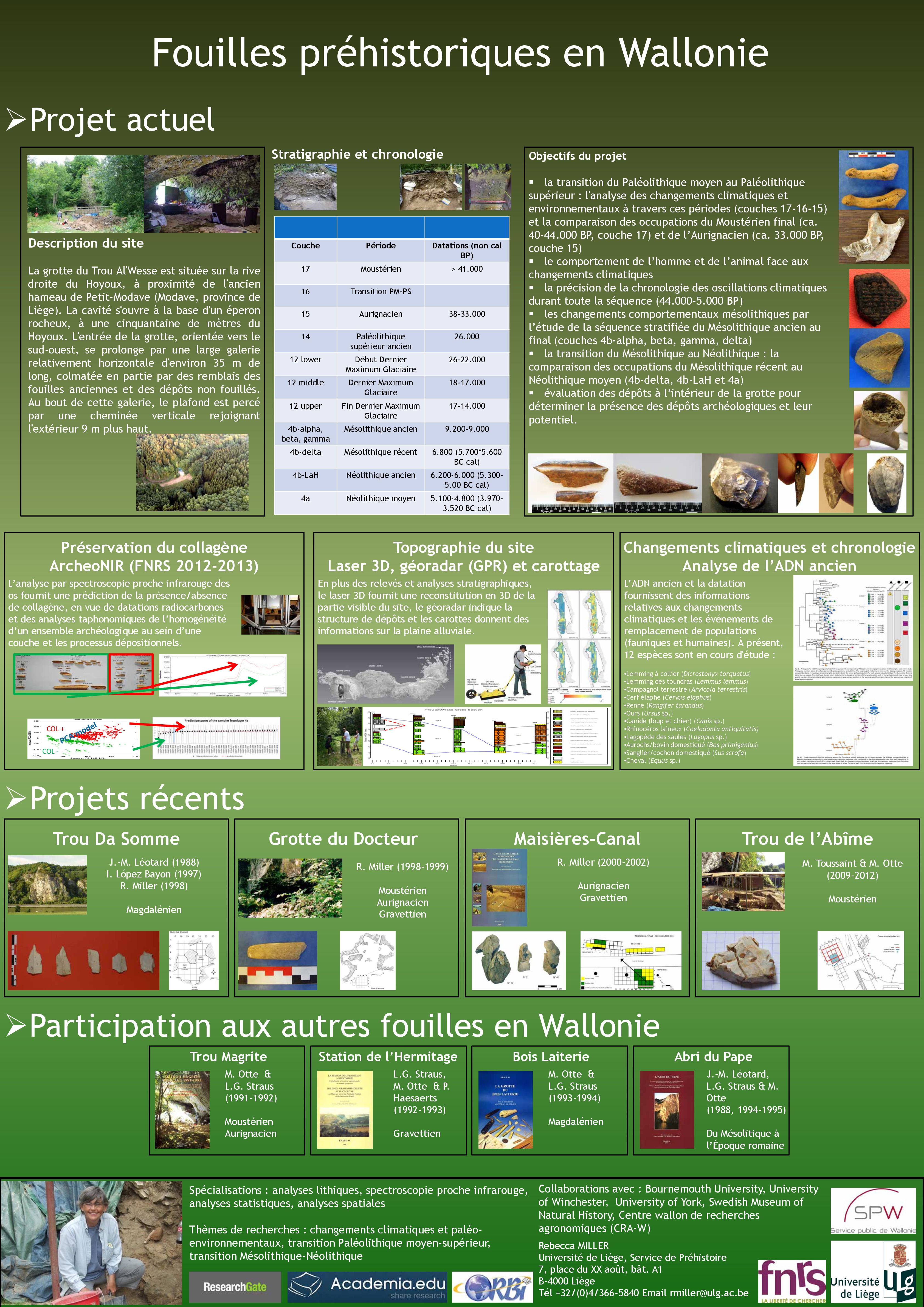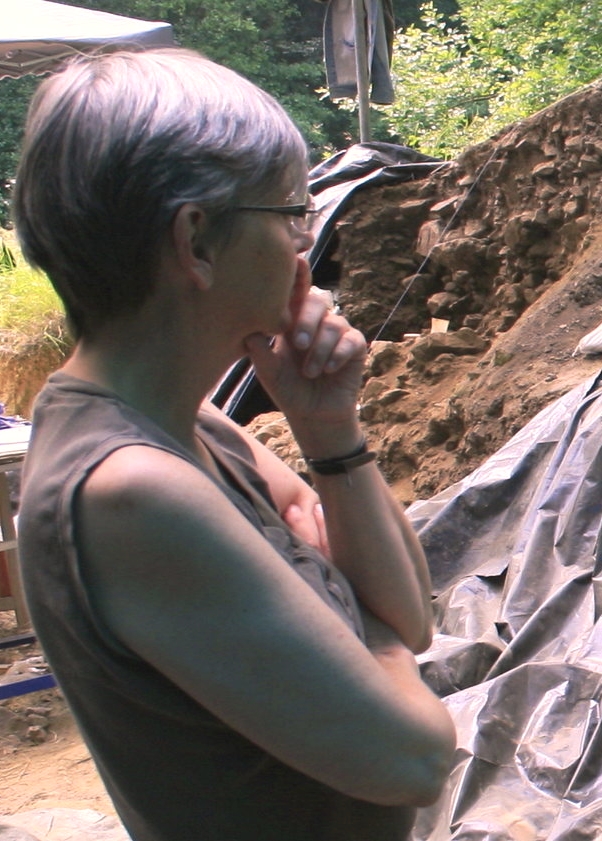Dr. Rebecca Catherine Miller | 1964-2017
Becky was born Dec. 4, 1964, in Waterloo N.Y., daughter of Patrick Miller and Diane (Walker) Miller. She died unexpectedly March 20 in Johnson City, N.Y. She graduated from Columbus High School in 1982. She continued her education at University of Chicago, earning a bachelor’s degree in anthropology in 1986; a master’s degree in 1992 and doctorate in 2000 in anthropology with a specialization in archeology from University of New Mexico. In 1994 she was awarded the Belgian-American Educational Foundation scholarship and in 1996 she was awarded the Fellowship of the Fulbright Foundation scholarship to continue her research. In 1997 she began her career as an archeologist/professor at the University of Liege Prehistory Department in Liege, Belgium. She conducted excavations at numerous Palaeolithic sites in Belgium and participated in projects in Karain and Okuzini, Turkey and the Tangier Region (Morocco). Since 2003 she was responsible for the excavation at Trou Al’Wesse Belgium.
Dr. Rebecca Catherine Miller
was awarded several research funding especially for her project entitled “The Middle-Upper Paleolithic transition at Trou Al’Wesse (Belgium)”:
Trou Al’Wesse research’s presentation:
The replacement of Neandertals by modern humans during the Middle-Upper Paleolithic transition has been a longstanding debate with principal arguments focusing on either interspecific human competition or climatic driven environment change. Recently, dates ~36,000 uncal BP obtained from Spy Cave suggest that Neandertals persisted until relatively late in the area. Given that the earliest UP dates in Belgium are 34-33,000 uncal BP, Neandertals and modern humans may have been broadly contemporary. The terrace of the cave site of Trou Al’Wesse in Belgium has a largely unexcavated stratified sequence in units 17 to 15 (MIS 3-2) with Late Mousterian human occupations in unit 17 and Aurignacian in unit 15. It thus offers a good opportunity to obtain detailed behavioral, climatic and paleoenvironmental data for the MP-UP transition and to assess the degree to which climatic oscillations might have affected the presence of hominids in Northwest Europe. This project will ideally contribute to clarifying the timing of the end of the Neandertal occupation and the arrival of anatomically modern humans, changes in climatic and environmental context that affected human presence, and behavioral responses and adaptations to climate and environmental change across the transition.
The importance of this site (Figure 1) is due to a) its geographic location on a tributary south of the Meuse and thus relatively isolated from the concentration of other Belgian Paleolithic sites in the eastern and western parts of the Meuse Basin, b) evidence of repeated human occupation during the Mousterian, Aurignacian, Mesolithic and Neolithic periods and c) the presence of a relatively complete stratigraphy from Marine Isotope Stage (MIS) 3 onwards (the terrace fronting the cave has a stratigraphic sequence spanning the period > 45,000 to 4,000 uncal BP) with which to study climate variability and environmental change associated with hominid activity.
During the 2015 field season, funded by The Leakey Foundation, excavation was conducted in the L-M 4-10 rows in the middle of the zone containing units 17 and 16 (Figure 2). An interdisciplinary approach was applied to record the sedimentary context during excavation, analyze the geological data, lithic and faunal data, reconstruct the chronological framework for the Neandertal occupations and ultimately, the climatic and environmental context. This approach is based on microstratigraphic, taphonomic and spatial analyses to reconstruct site formation processes and evaluate the depositional context, analysis of the lithic assemblages (technology, typology, taphonomy, raw materials), analysis of the faunal assemblages to study behavioral aspects (prey choice, processing, bone tool production) and reconstruct environment and climate phases. Dating of the sequence using OSL and AMS is in progress to propose a chronology for human presence/absence and climatic and environmental change for the ca. 50,000-30,000 BP period covered.
We are all very pleased with the results of the 2015 season, and even more so that The Leakey Foundation has now funded a second season to continue the excavation of these units within the overall 5×4 m area containing this sequence. Alongside the ongoing lithic, faunal and geological analyses, additional analyses supported by the 2016 Leakey grant include near infrared spectroscopy to detect and evaluate collagen content in bone for sample selection prior to AMS dating, pollen analysis for paleoenvironmental reconstruction and LA-ICP-MS analysis in an exploratory study to source the lithic raw materials exploited at Trou Al’Wesse.
From the Field: Rebecca Miller | 2015, The Leakey Foundation
Dr. Rebecca Miller (Spring 2015 Grantee), with co-investigators Dr. John Stewart and Dr. Keith Wilkinson, completed this summer’s Leakey Foundation funded field season at the site of Trou Al’Wesse in Belgium. With an enthusiastic and meticulous team of students from the University of Liège, Bournemouth University and Winchester University, as well as two students doing doctoral and Master’s research on paleoecological and geological aspects of the site (Monika Knul, PhD student from BU and Eden Richards from U of W), this season was particularly productive.
Trou Al’Wesse (“Wasp Cave” in Walloon) is a large cave on the Hoyoux River, a tributary of the Meuse River, located near the village of Modave. It extends back ca. 45 m and connects to a karstic network, with a chimney open to the surface above (formerly filled with deposits excavated in the 19th century that yielded a multiple Late Neolithic burial). Facing southwest, it overlooks the alluvial plain of the Hoyoux. It is situated in the nature preserve owned by Vivaqua, a major Belgian water company with a strong sense of responsibility of cultural and natural preservation. The nature preserve protects many rare and threatened species, including several bat species that hibernate at Trou Al’Wesse. Additionally, they are owners of the nearby Château de Modave, principally 17th century although occupation dates back to the early 13th century. Finally, Vivaqua has been a generous supporter of the Trou Al’Wesse project since the beginning, providing logistical support and assistance in protecting the site.
The Leakey-funded excavations took place on the cave terrace, focusing on the Middle to Upper Paleolithic transition in units 17 and 16. The chronological focus of the terrace excavations is the MP-UP transition and the Early Upper Paleolithic, from roughly 50,000 to 30,000 BP. In the Pleistocene sequence, this includes units 17 (Mousterian) and 16 (non-archaeological but fauna-rich unit) underlying unit 15 (Early Upper Paleolithic with Aurignacian layers). The principal objective is to study the climatic and environmental context and chronology of human occupations across the MP-UP transition in order to evaluate the factors affecting Neanderthal extinction and the arrival of the first modern humans in northwest Europe. Trou Al’Wesse is the only site in Belgium currently known and one of the rare sites in Northwest Europe with an intact (i.e., unexcavated) stratigraphy covering this period. It is also comparable in cave morphology and size to the eight Belgian sites that have yielded Neanderthal human remains (Engis, La Naulette, Fonds-de-Forêt, Grottes de Goyet, Grotte de Spy in the 19th century and Trou de l’Abîme à Couvin, Grotte Scladina, and Grotte Walou in the late 20th century), suggesting the possibility of discovering new Neanderthal remains in stratigraphic context using modern methodology and techniques.
The goals for the 2015 season were to excavate the Neanderthal occupations with Late Mousterian lithic assemblages in unit 17 and non-archaeological unit 16 on the TAW terrace, collect data to study climatic and environmental variability, clarify the stratigraphic sequence of these units 17 and 16 (previously excavated only in the 1990s in a limited area on the terrace), select bone and charcoal samples for AMS dating of this sequence and collect sediment samples and install dosimeters for OSL dating.
The season was quite successful, with unit 17 containing Mousterian layers extremely rich in lithics, fauna, burned bone and charcoal and unit 16 proving to be very complex with several layers that will provide information on climatic oscillations during a phase in which humans were absent from the site.
On the terrace, units 17 and 16 in the M row squares were excavated, starting with M6 (next to M5, which was excavated in the 1990s) to M10, 4 m further from the cave entrance toward the alluvial plain and the Hoyoux River. Half-squares were also opened in M7, M8 and M9 to excavate unit 16. The richness of the Mousterian layers was immediately shown in M6, where, in a single 50x50x25 cm subsquare (M6C), in layers 17a and 17b, more than 700 lithics and bones were recorded in 3 dimensions and many more found during water-sieving to 0.5 mm. Adjacent subsquare L6D was also opened and proved to be as rich. This density necessarily slowed down the expected rate of advancement (initially, our goal was to excavate squares M-N 6-10). At the end of the season (as always!), the top of the Mousterian unit was reached in squares M10 and M9. The Mousterian occupation area extends across the entire zone on the terrace and will be further investigated in spring 2016 and during the summer 2016 field season.
Excavation also continued in a sample column begun in 2014 by M. Knul (BU) and E. Richards (U of W). In 2014, the column had nearly reached the contact between units 15 and 16. Faunal remains here are often much larger, likely due to rapid redeposition and also the probable location of rows up to at least row 6 beneath the former overhang of the cave or even inside the cave entrance. Cryoclastic activity has caused major collapse from the cave face, creating the clast-based Pleistocene deposits on the terrace. Bones identified in the field include woolly rhinoceros, cave bear, horse, reindeer, red deer, arctic fox, mustelids, lemmings, voles, fish and birds.
The Mousterian lithic assemblages from layers 17a and 17b include many tools (sidescrapers, retouched flakes), core fragments, core preparation and reduction by-products and tiny flakes and splinters. The raw materials used are varied: several varieties of fine and medium-grained flint, flint river cobbles, good quality phtanite, fine-grained quartzite. Raw material sourcing is in progress, although the phtanite source is already known to be non-local, in the Ottignies-Mousty region about 70 km WNW (across the Brabant and Hesbaye Plateaux where at least some of the flint is likely to be from, and crossing the Meuse River, where river cobbles would have been available on the river terraces). The lithics are unpatinated and have fresh edges and ridges, suggesting rapid deposition and little post-depositional movement. For subsequent use-wear and residue analysis, none of the artifacts have been handled or processed. Refitting analysis has a good probability of success and will be done after the use-wear analysis.
Bone remains are abundant, ranging from fragments to larger elements. Significant amounts of burned bone and charcoal fragments were also present in layers 17a and 17b, although no hearth features have as yet been found.
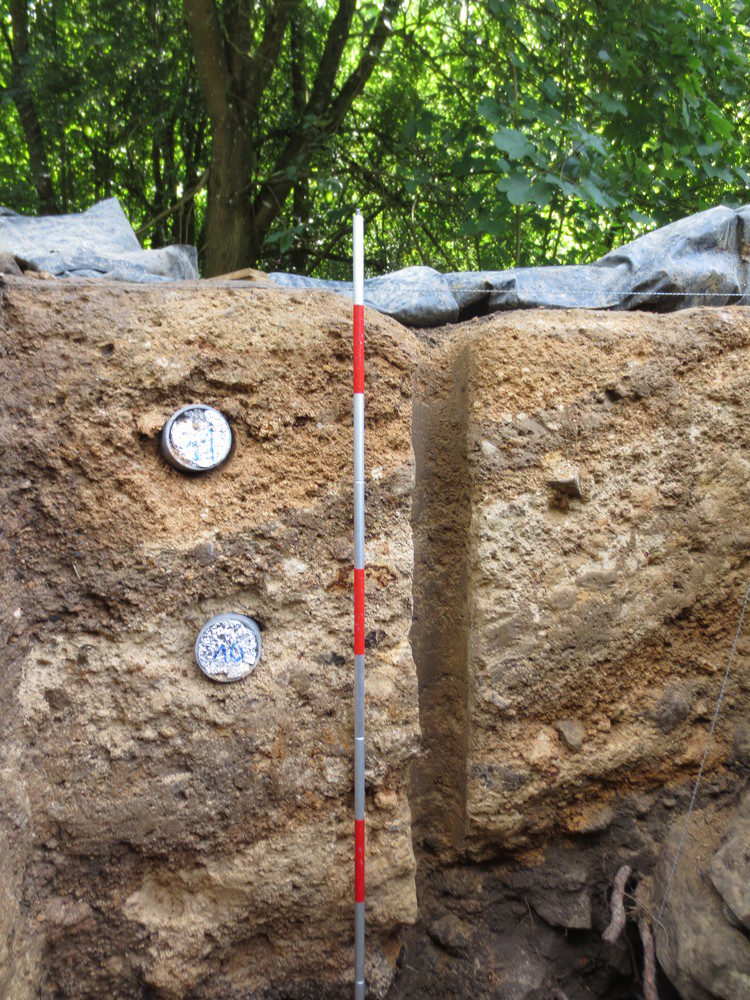
Dosimeters for calibration in post-medieval alluvial deposits in test pit J-K 27-28 (adjacent to borehole from 2012)
In unit 16, faunal density varies by layer and analysis of the small mammal fauna in particular will contribute to reconstructing the climatic sequence. Larger fauna so far includes woolly rhinoceros and cervids, identified in the field; faunal analyses are in progress.
In addition to the Leakey-funded part of the project, the excavation of two test pits TP2005 and TP2013 inside the cave was continued. The layer currently reached in TP2005 contains cave bear remains apparently representing a hibernation den. In TP2013, after removal of several phases of backfill from 19th and 20th century trenches and a tunnel, the unexcavated Pleistocene layers yielded an Aurignacian endscraper on a long large blade, indicating that the cave deposits will also contain Aurignacian and very likely Mousterian occupations.
Samples will be selected for AMS dating based on stratigraphic layer and identification (e.g., species or bone tool) as well as those directly associated with sediment samples collected for OSL dating. For OSL dating, two specialists working with Johannes Van Der Plicht (Leiden University), Tony Reimann and Christina Ankjaergaard from Wageningen University, came to Trou Al’Wesse and collected sediment samples and inserted dosimeters.
We are now busy with lithic, faunal and geological analyses, sample selection for AMS dating and post-excavation processing and sorting of water-sieved sediments. Over the next several months, we will start to have a clearer picture of the stratigraphic sequence, palaeoenvironmental change and Neanderthal activities during the Late Mousterian. In addition, preliminary talks will be presented at the annual Journées d’Archéologie wallonne (November 19-20, Rochefort) and FNRS “Prehistory” Contact Group meetings in Belgium (December 13, Malines).
Neandertal and Denisovan DNA from Pleistocene sediments
Viviane Slon, Charlotte Hopfe, Clemens L. Weiß, Fabrizio Mafessoni, Marco de la Rasilla, Carles Lalueza-Fox, Antonio Rosas, Marie Soressi, Monika V. Knul, Rebecca Miller, John R. Stewart, Anatoly P. Derevianko, Zenobia Jacobs, Bo Li, Richard G. Roberts, Michael V. Shunkov, Henry de Lumley, Christian Perrenoud, Ivan Gušić, Željko Kućan, Pavao Rudan, Ayinuer Aximu-Petri, Elena Essel, Sarah Nagel, Birgit Nickel, Anna Schmidt, Kay Prüfer, Janet Kelso, Hernán A. Burbano, Svante Pääbo, Matthias Meyer
Abstract: Although a rich record of Pleistocene human-associated archaeological assemblages exists, the scarcity of hominin fossils often impedes the understanding of which hominins occupied a site. Using targeted enrichment of mitochondrial DNA we show that cave sediments represent a rich source of ancient mammalian DNA that often includes traces of hominin DNA, even at sites and in layers where no hominin remains have been discovered. By automation-assisted screening of numerous sediment samples we detect Neandertal DNA in eight archaeological layers from four caves in Eurasia. In Denisova Cave we retrieved Denisovan DNA in a Middle Pleistocene layer near the bottom of the stratigraphy. Our work opens the possibility to detect the presence of hominin groups at sites and in areas where no skeletal remains are found.
Article on line, Science | The Telegraph April 28, 2017, Prehistoric human DNA is found in caves without bones in ‘enormous scientific breakthrough’
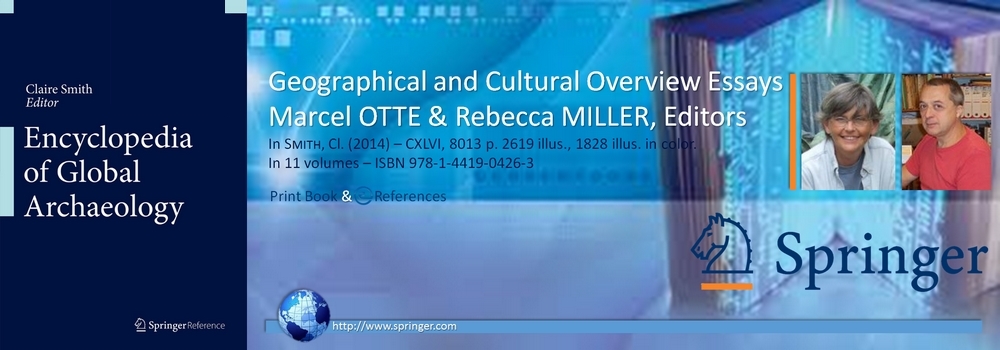
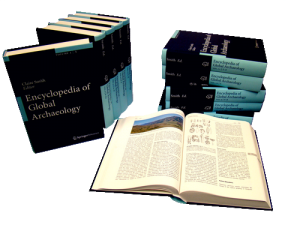
This immense work is unique in combining extremely varied theoretical approaches, too often dissociated. We also aimed to present highly stimulating results and often neglected perspectives. Ethnoarchaeology and Prehistory of Societies hardly considered as exotic have a key role. Entirely new data and that simply ignored due to common ethnocentrism finally are given their true value, as well as their authors. Preparation of this work took place over the last several years and covers societies all around the world seeking legitimate recognition, acquired here by the consideration of their own past, the basis of their modern dignity.
An online version is also available.
Rebecca Miller | Le site préhistorique du Trou Al’Wesse, Modave | Collection Origines, 2014
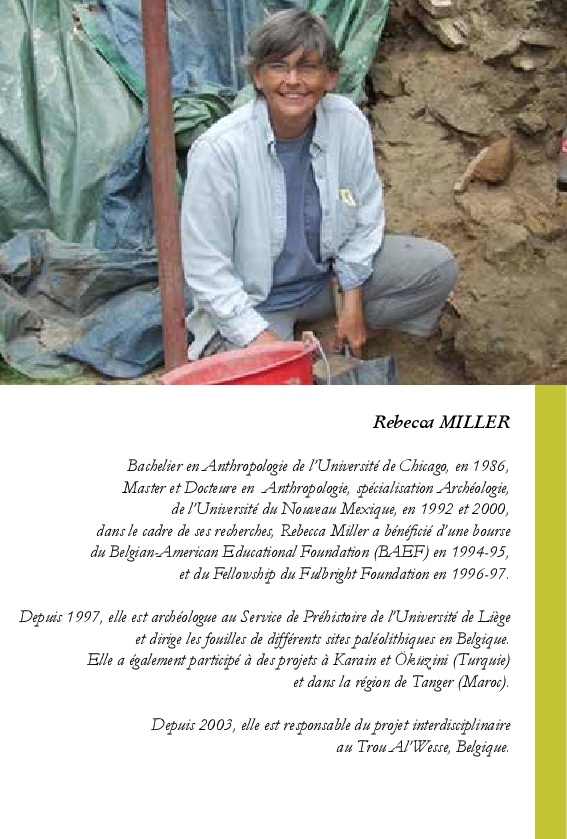 La « guêpe » du Trou Al’Wesse constitue tout un symbole ! Avec ses collègues insectes, elle caractérise le micro-climat local où les fruitiers sauvages l’attirent, tout comme nous lors de piqueniques. Le saillant calcaire où s’ouvre la grotte emmagasine la chaleur, hiver comme été, pour la restituer la nuit. Il agit telle une pile, car, en cet endroit, la vallée est assez large pour ne laisser aucune ombre couvrir le versant abrupt et d’orientation favorable. Outre l’abri naturel, constitué par la grotte, une clairière chatoie devant sa terrasse ; elle va ensuite s’enfoncer dans le sous-bois bordant les fraîcheurs du Hoyoux. Autant que les guêpes, les hommes ont toujours su apprécier cette courbe paradisiaque de la rivière, fort heureusement préservée intacte par la Compagnie Bruxelloise des Eaux : tout se tient !
La « guêpe » du Trou Al’Wesse constitue tout un symbole ! Avec ses collègues insectes, elle caractérise le micro-climat local où les fruitiers sauvages l’attirent, tout comme nous lors de piqueniques. Le saillant calcaire où s’ouvre la grotte emmagasine la chaleur, hiver comme été, pour la restituer la nuit. Il agit telle une pile, car, en cet endroit, la vallée est assez large pour ne laisser aucune ombre couvrir le versant abrupt et d’orientation favorable. Outre l’abri naturel, constitué par la grotte, une clairière chatoie devant sa terrasse ; elle va ensuite s’enfoncer dans le sous-bois bordant les fraîcheurs du Hoyoux. Autant que les guêpes, les hommes ont toujours su apprécier cette courbe paradisiaque de la rivière, fort heureusement préservée intacte par la Compagnie Bruxelloise des Eaux : tout se tient !
À l’aube de son Histoire, notre Royaume chercha à définir et à comprendre ses origines. Ce furent aussi les débuts de la Préhistoire elle-même, science pionnière en Belgique. En 1863, Caumartin, dans le récit d’une promenade le long du Hoyoux, donna une description sommaire de la grotte qui venait d’être découverte (« il y a quelques années ») en recoupant des taillis. À ce moment, la grotte, qui n’avait « jamais été explorée à fond », était encore presque entièrement comblée par les sédiments. Caumartin a signalé en effet que « la voûte s’abaisse de suite » et qu’il fallait y pénétrer « à plat ventre », bien que l’entrée fut « belle et spacieuse » (Caumartin, 1863, p. 8 ; Otte, 1979, p. 427).
L’histoire des fouilles qui s’y déroulèrent est pleine d’imprécisions et les documents dont nous disposons aujourd’hui sont extrêmement réduits. Au cours du XIXe siècle, le Comte de Looz est venu « visiter » la grotte (Fraipont et Braconnier, 1887, p. 403 ; Rahir, 1925, p. 46), sans que nous sachions si cette « visite » comportait des fouilles, ni ce qu’il est advenu des éventuelles découvertes. Édouard Dupont y a ensuite ouvert une tranchée de « quelques mètres de long, à l’entrée » (Fraipont et Braconnier, 1887, p. 403). Cependant, il n’a jamais publié le résultat de ces recherches, si ce n’est d’une manière succincte dans le cadre d’études générales sur la stratigraphie des grottes belges (Dupont, 1872a, tabl. synoptique ; 1872b, p. 131-132). Entre 1885 et 1887, Ivan Braconnier, propriétaire du château de Modave, reprit des fouilles, secondé par J. Fraipont et M. Lohest. Elles s’étendirent à l’ensemble de la grotte, mais, une fois encore, aucune publication ne fut consacrée aux résultats de ces campagnes. Certains aspects des découvertes ne sont connus que par des allusions dans divers travaux généraux, spécialement ceux de Julien Fraipont (1898, p. 342) ou encore dans ceux consacrés à la « céramique paléolithique » (Fraipont et Braconnier, 1887) (Otte, 1979, p. 427-429).
D’autres recherches ont été exécutées par le Service des Fouilles du Cinquantenaire, car nous avons trouvé des notes de terrain (1912) consistant en relevés topographiques conservés dans les archives manuscrites de A. de Loë à la section Belgique ancienne des M.R.A.H. Peut-être ces travaux se sont-ils limités à ces relevés ; dans tous les cas, nous n’en possédons aucune trace, ni sous forme d’allusion dans la littérature, ni sous forme de documents déposés dans les réserves des M.R.A.H. De plus, Mlle H. Danthine nous a appris que J. Hamal-Nandrin avait repris des fouilles dans la grotte, mais qu’elles n’ont donné lieu à aucune publication (Otte, 1979, p. 429).
Plus récemment, des travaux ont été entrepris dans la prairie précédant la grotte par J. Destexhe-Jamotte. Seule une occupation néolithique y a été rencontrée (Otte, 1979, p. 429).
Le Trou Al’Wesse, dans l’humilité de sa vallée, reconstituait le contact entre les deux principales populations humaines en Europe : néandertalienne et moderne, aux fondements de notre continent ; il fallait en savoir plus !
Dans les années 1990, de nouvelles fouilles furent menées, en collaboration entre l’Université de Liège (Marcel Otte) et les Chercheurs de la Wallonie (Fernand Collin). Les installations à la grotte se révélèrent importantes surtout pour la période des « derniers chasseurs », durant les phases climatiques tempérées, analogues à celles d’aujourd’hui. Mais nous y avons aussi reconnu l’existence des premiers Hommes modernes, sur un espace très restreint, au plus profond des sondages devant la grotte en terrasse, qu’une masse d’éboulis a formée. En effet, lors de phases climatiques rigoureuses, les roches calcaires s’effritent en surface par l’action alternée du gel et de l’humidité. De fins cailloutis s’accumulent au pied des parois, parfois sur d’énormes épaisseurs, témoignant de ces conditions rigoureuses, et ensevelissent progressivement tous les restes laissés par l’homme. Vers le milieu de la période glaciaire, il y a environ 35.000 ans, la population moderne pénétra en nos régions et les Néandertaliens disparurent progressivement, apparemment en raison d’un rythme démographique plus lent. Modave et son abri favorable constituaient un relais apparemment connu par les populations de chasseurs nomades, à différentes époques. Cet « effet d’appel », dû à la topographie et au micro-climat, constitua un piège naturel où les traces s’accumulèrent jusqu’aujourd’hui. L’élaboration des méthodes de fouilles et d’analyses fournit désormais des informations précises sur les modes de vie, l’environnement et les valeurs de ces populations originelles, celles qui par exemple créèrent Chauvet, puis Lascaux. Il s’agit donc des sources de nos sensibilités et pas seulement de notre anatomie. Tout ceci constitue un patrimoine commun, à faire connaître, respecter et aimer : cette plaquette n’a pas d’autre ambition.
Rebecca Miller | Excavations 1992-2017
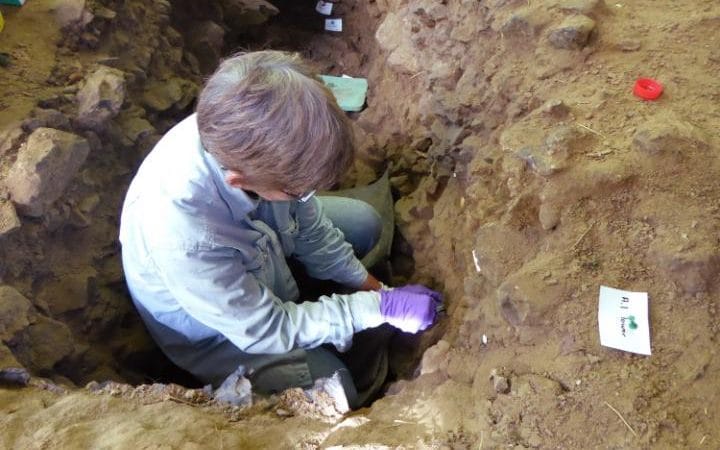
Rebecca Miller sampling sediment for genetic analyses at the archaeological site of Trou Al’Wesse, Belgium | Credit: Max Planck Institute for Evolutionary Anthropology
Monographie : R. Miller, P. Haesaerts, M. Otte (dir.), 2004. L’atelier de taille aurignacien de Maisières-Canal (Belgique). Liège, ERAUL 110.
Monographie : M. Otte, A. Bouzouggar & J. Kozlowski (dir.), 2004. La Préhistoire de Tanger (Maroc). Liège, ERAUL 105.
Monographie : I. Yalçinkaya, M. Otte, J. Kozlowski & O. Bar-Yosef (dir.), 2002. La grotte d’Öküzini: évolution du Paléolithique final su Sud-Ouest de l’Anatolie. Liège, ERAUL 96.
Monographie : M. Otte & L.G. Straus (dir.), 1997. La grotte du Bois Laiterie. Recolonisation magdalénienne de la Belgique. Liège, ERAUL 80.
Monographie : J.-M. Léotard, L.G. Straus & M. Otte (dir.), 1999. L’Abri du Pape. Bivouacs, enterrements et cachettes sur la Haute Meuse belge : du Mésolithique au Bas Empire Romain. Liège, ERAUL 88.
Monographie : L.G. Straus, M. Otte & P. Haesaerts (dir.), 2000. La station de l’Hermitage à Huccorgne. Un habitat à la frontière septentrionale du monde gravettien. Liège, ERAUL 94.
To our beloved friend and colleague,
To her mother Diane Walker Miller, her two brothers, Daniel Amanda Miller of Johnson City, N.Y., & Nicholas Rachel Miller of Seattle, her sister, Amy Wil Coloma of Seattle, her four nephews, Braeden of Johnson City, Chris, Colin & Connor, all of Seattle, and her two nieces, Caitlin & Camryn, both of Seattle…
Marcel OTTE | Becky ne s’oublie pas…

Jamais, la mort n’a souhaité être aimée. Elle commet parfois des excès de zèle et elle frappe dur ! Elle a choisi de s’abattre prématurément sur la plus tendre de nos proches, Rebecca Miller (1964-2017), infatigable, dévouée, passionnée, compétente, petit miracle comme la Préhistoire le sait produire dans ses meilleurs moments.
Son bilinguisme parfait fut offert à chacun, avec générosité, pertinence et discrétion. Son enthousiasme d’enfant l’a fait venir des Amériques pour fouiller en Turquie, puis au Maroc, à Maisières, à Couvin, et enfin à Modave, où elle dirigeait le chantier du Trou Al’Wesse depuis plusieurs années. Aucune école ne fut si heureuse, n’apprenait avec tant de ferveur la rigueur des méthodes qu’elle dispensait aux étudiants avec un plaisir non dissimulé et une bienveillance toute maternelle.
Elle s’est lancée à la poursuite du phénomène humain, de la dispersion des roches selon des réseaux géographiques, à l’ADN fossile, avec un empressement fasciné par la découverte… On la trouvait tard au labo, sur le chantier, disponible pour tous à chaque instant, soirées et week-ends inclus. En constante effervescence, pétillante d’attention et d’humour, d’une joie inébranlable, jusque dans les pires instants qui l’ont emportée… Alors que son corps n’était plus que douleurs, elle souriait toujours à la moindre attention. Elle savait donner. La mort ne sait que prendre, mais elle ne pourra nous arracher le souvenir de notre chère Becky…





